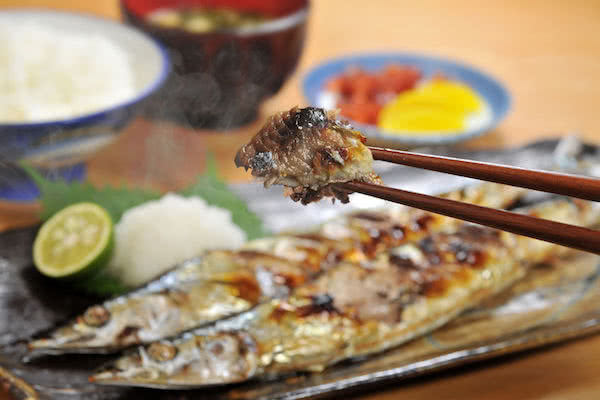
A traditional Japanese breakfast is likely different from any other kind of breakfast you'll ever experience. It consists of foods that make up a complete meal that one could conceivably enjoy at lunch or dinner.
Typically, a traditional Japanese breakfast consists of steamed rice, miso soup, a protein such as grilled fish and various side dishes. Familiar side dishes may include tsukemono (Japanese pickles), nori (dried seasoned seaweed), natto (fermented soy beans), kobachi (small side dishes which usually consist of vegetables), and green salad.
Although a Japanese breakfast comprises what Westerners might view as a complete meal appropriate for lunch or dinner, it is not intended to be heavy or too filling. Portion sizes for breakfast are adjusted to meet one's appetite, and dishes tend to lighter, for example, they tend not to be greasy, deep fried, or rich.
How Do You Prepare a Traditional Japanese Breakfast?
Although there seems to be a number of components to creating a traditional Japanese breakfast, try to keep it simple by incorporating one item from each of the following: 1) rice dish; 2) soup; 3) protein (fish, egg, or fermented soybeans); and 4) side dish (pickles or other vegetable dish). Complete your meal with a cup of hot green tea.
To save time, Japanese families often have leftover steamed rice warming in a rice cooker or porridge that is cooked using the timer feature in a rice cooker. Leftover miso soup from the night before may also be reheated.
Other shortcuts include pre-made pickles (tsukemono) or preserved kelp (tsukudani), as well as individual portions of pre-packaged fermented soy beans (natto) or other rice seasonings (furikake or dried seaweed) available for sale at the grocery store.
What Dishes are Included In a Traditional Japanese Breakfast?
- Steamed Rice (Gohan)Plain steamed rice, either white rice (hakumai) or brown rice (genmai), is an essential dish that accompanies the proteins and side dishes of breakfast, and should definitely be included.
- Miso Soup (Miso Shiru)Miso soup is a traditional Japanese soup made from fermented soybean paste (miso), and a dashi broth. Familiar ingredients include tofu, chopped green onion, wakame seaweed, aburaage (deep-fried tofu), Japanese mushrooms, clams, or other seasonal ingredients. Miso soup made from scratch (paste and dashi broth) is common in Japanese households, but pre-seasoned dashi infused miso paste (just add water), as well as instant miso soup packets (available in both dried and wet packs) for individual use, are also readily available for sale.
- Fermented Soy Beans (Natto)Natto is served over steamed rice and this dish of natto rice is considered a high protein Japanese breakfast staple. It is a rustic dish of fermented soybeans characterized with a strong aroma and slimy texture. It is seasoned with soy sauce, along with optional ingredients such as dried bonito shavings (katsuobushi), chopped green onions, spicy mustard (karashi), sliced dried and seasoned seaweed (kizaminori), or other flavor add-ins. Packaged natto is available in the refrigerated section of Japanese and Asian grocery stores.

- Grilled Fish (Yakizakana)Fish is a very popular breakfast protein and is either broiled in the oven or quickly cooked in a pan. It is often seasoned simply with salt, and salmon is a favorite for Japanese breakfasts. Another popular fish is dried horse mackerel (aji), but any favorite type of fish may be enjoyed for breakfast.


- Pickled Vegetables (Tsukemono)Tsukemono is a staple side dish in Japanese cuisine as it is meant to accompany any type of rice dish. One well-known type of tsukemono is pickled plum, known as umeboshi. It goes well with both plain steamed rice and rice porridge. A wide assortment of pickles is available in the refrigerated section of Japanese and Asian grocery stores.
- Seasoned Dried Seaweed (Nori)Dried and seasoned seaweed (ajitsuke nori) is also a staple in Japanese cuisine as it is meant to be eaten with steamed rice. Because it is seasoned, it can be enjoyed as is, with rice, but it can also be dipped in a small plate of soy sauce and then wrapped with rice. Seaweed with rice is often commonly enjoyed for breakfast. Individually
Tuna Kabochi - Vegetable Side Dishes (Kobachi)Vegetables are also common in Japanese breakfasts. These are usually small portions, and these types of small dishes (not limited to strictly vegetables) are known as kobachi. Aside from pickles and seaweed, both cooked vegetables, as well as fresh salads may be included in a traditional Japanese breakfast.
Dont forget to check my new site here!









Tidak ada komentar:
Posting Komentar